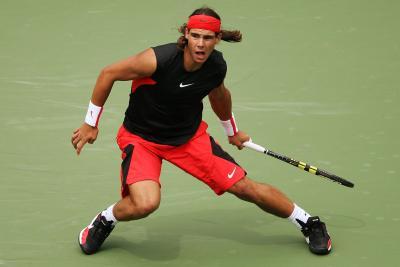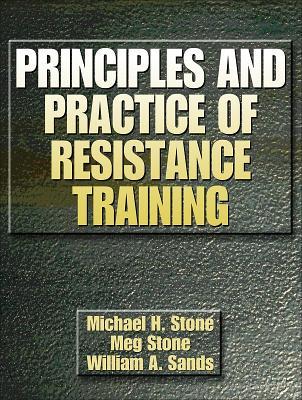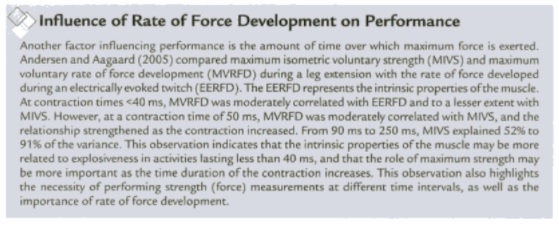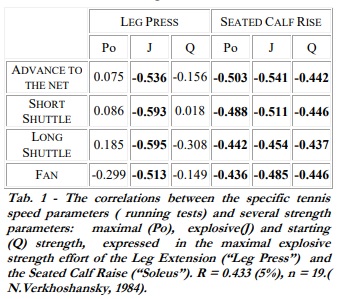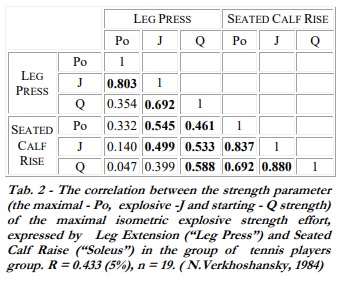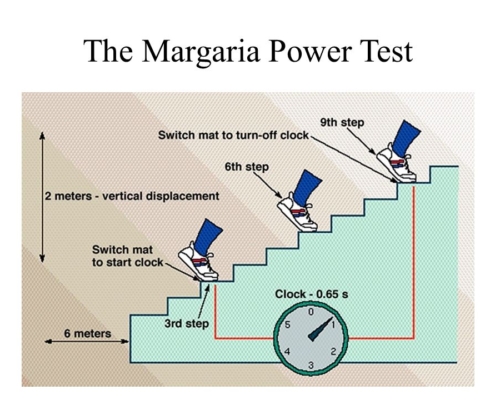The Force-Velocity Curve for Tennis – Part 1
In today’s blog I’m going to introduce an important concept- the Force-Velocity (F-V) Curve and how we can use it to write better S&C programmes for Tennis performance. A lot of us (myself included) have at one point probably blindly followed a model for improving ‘performance’ without really taking time to understand how certain types of strength and power exercises might relate to the actions in the sport- in this case Tennis.
One way to conceptualise the forces acting on the body is by using the F-V curve and placing various tennis actions on the curve. I ask my coaches to do this exercise when they first work in Tennis with APA and so in Part 2 of this blog I will present an example from one of my coaches.
Before we get to the F-V curve in Part 2 I wanted to establish some definitions in Part 1, as this is where we can get a lot of confusion. I must give credit to Matt Kuzdub who has written a lot of fantastic blogs on the topic of tennis science, and he talks extensively about strength and power- giving examples of how this relates to tennis.
Check out this article from Mattspoint.com who does a great job of outlining how max strength development can impact movement characteristics – including explosiveness, first step ability and acceleration. He mentions that: ”tennis is characterized mainly by explosive (speed-strength) actions. This basically means that the majority of movements in tennis are quite ballistic and fast – and I strongly believe training should reflect this (both on and off the tennis court). That being said, there’s a place for maximum strength training in the overall program (and development) of an elite tennis player.”
I have heard so many coaches talk about this term ”explosiveness” as a bit of a catch all term that I thought it warranted a Part 1 to present some terms definitions first. To set the scene, I’m going to quote another section of Matt’s blog where he talks about ‘explosiveness’ from his point of view. ?
What’s Explosiveness Anyway?
”Explosiveness – what sport scientists refer to as explosive strength or rate of force development (RFD) – differs from maximal strength. Explosive strength is related to how quickly a muscle or muscle group can develop force to produce a desired movement. In this context, achieving max force is not a requirement.
As you would probably suspect, this quality is quite important for tennis players – every time a player initiates movement, they are attempting to be explosive. Explosive strength is generally trained using lighter resistances (barbell jump squats, power snatch/clean etc.) or via traditional plyometric activities (jumps, bounds, sprints etc.). Many would argue that explosive strength is more important than maximum strength in tennis (myself included).”
⭐️ Daz comment: I’d now like to offer my own definition of Explosiveness, as there are lots of terms such as maximum strength, explosive strength, power, acceleration strength, strength-speed, speed-strength, starting strength, reactive strength that all get referred to. Needless to say it can get very confusing! I don’t necessarily disagree with what Matt has said above, BUT if I’m going to be picky I’d say that explosiveness as it is defined as a strength quality is a little different. The challenge we have is that typically explosiveness and ‘power’ are words that used interchangeably. which isn’t strictly correct.
Terminology
I’ll offer definitions for Maximum strength, RFD, Power and Speed as a start point. Everything else that gets referred to is in someway connected to the above mentioned terms. If you aren’t a science geek and just want some practical take aways, you’re probably best to skip to Part 2, where I give you an example of tennis movements that rely on various amounts of Force and Velocity.
A lot of the definitions are based on a chapter I read in:
Strength
Strength = the ability of the neuromuscular system to produce force against an external resistance.
Absolute maximum strength (AMS) = the greatest amount of strength that a muscle or one or more groups of muscles are capable of producing, and can be determined isometrically or dynamically.
? superimposing an electrical stimulation on a maximum voluntary contraction, thus augmenting motor unit recruitment, can produce AMS. Maximum voluntary strength is the maximum amount of strength that can be produced voluntarily without electrical augmentation. For the purposes of simplicity I will refer to this as ‘Maximum strength’ and practically speaking this is usually obtained in a laboratory as peak force during a single joint movement and isolated muscle. Training for this quality is most typically associated with heavy resistance training exercises above 85% of 1RM.
This will likely not relate well to the complex use of muscles during multi-joint movements. As it relates to sport, one can argue the importance of strength (force) by considering Newton’s second Law of Motion, F = ma. Thus increasing the level of acceleration requires a greater force production; and because acceleration results in some velocity, greater forces will produce higher velocities. Therefore achieving high velocities is dependent on high force production (strength).
Therefore, one may argue that in some sports, perhaps most sports, RATE OF FORCE DEVELOPMENT is as important, or more important, than maximum force production (maximum strength).
Force production characteristics, including the rate at which force is produced, and related variables such as power production, can be as important as, or even more important than, the maximum level of force production.
Rate of Force Development
Rate of Force Development (RFD) = is the change in force divided by change in time and is directly related to the rate of increase in muscle activation by the nervous system. Although force is directly responsible for the acceleration of an object, one may argue that the faster a given force is attained, the more rapid the corresponding acceleration of a mass. Thus, RFD can be associated with the ability to accelerate objects. Therefore, attaining a high average or peak RFD (explosive strength) is associated with high acceleration capabilities.
Measurement of RFD requires special equipment, usually a force plate is used for RFD measures of athletic movements. For example, an athlete could perform an isometric squat or static (no counter-movement) or dynamic (counter-movement) jumps from a force plate, and one or more force-time curves could be generated.
Explosive strength = the peak RFD has been termed explosive strength (PRFD), or stated anther way it’s the athlete’s capacity to achieve the peak force in the shortest time. Some coaches refer to this as ‘strength-speed.’ This has lead to a range of training methods which utilise moderate to heavy loads (e.g., 80-90% 1RM for Olympic lifts).
Starting strength = the force generated in the first 30 ms has been termed starting strength and is related to the initial rate of force development. Some coaches refer to this as high speed-strength (e.g., Verkhoshansky). This has lead to a range of training methods which utilise moderate to lighter loads (30-60% 1RM) and Slow SSC plyometrics (more on this later).
What does the Research Say?
It appears that a high starting strength and a high isometric and dynamic PRFD are necessary for optimal performance in sports in which light loads are moved very fast, for example fencing and boxing.
Support for this comes from Yuri Verkhonshasky who performed an experiment with athletes who did a Leg Press and a Seated calf raise under an isometric regime (without a time limitation) and a dynamic regime (where athletes had to perform a maximal explosive effort in the shortest time overcoming five different levels of resistance: 20, 40, 60, 80 and 100% of their maximum isometric strength).
In explosive movements executed with low resistance, it was found that starting strength is of primary importance. As resistance increases, explosive strength becomes more important.
To achieve the maximum speed of explosive movements, the relevance of maximum strength (measured as isometric strength in this example) depends on the level of external opposition to be overcome; the higher the external opposition, the higher the level of maximum strength necessary to ensure the maximal speed of movement.
In practical terms, the PRFD (or explosive strength) becomes increasingly important as the load increases (e.g., shot putt) and as the load approaches maximum, maximum strength predominates (e.g., powerlifting).
We would expect lighter loads to produce higher RPFD than heavier loads but it is also interesting to note that maximum strength and PFRD may be enhanced simultaneously with appropriate strength training. How could this be?
It comes down to the physiological potentiation effect of maximum strength training on explosive strength. Maximum strength training recruits high threshold motor units and increases the frequency of firing. To illustrate this lets look at an experiment by Natalia Verkhoshansky who followed up her father’s experiment with a similar one of her own as part of her PhD. This involved working with the former Soviet Union National tennis team.
In the table above we can see that the higher the level of explosive strength of the tennis player, the higher is their capacity to run rapidly on the court (r values approximately -0.5). The results also showed that the athletes who expressed a higher value of maximum strength and starting strength in the seated calf raise (BUT NOT LEG PRESS) showed a higher level of speed ability (r values -0.436 to 0.503 and -0.437 to -0.446 respectively).
So as we can see the results of specific running tests are NOT correlated directly with maximal strength as expressed in the Leg press. However, the correlations between the parameters of strength capabilities show that the higher the level of maximum strength, the higher is the level of explosive strength (see below r = 0.803).
This means that to increase the level of explosive strength in the leg press (a key quality to improve tennis running test performance), it’s first necessary to increase the maximum strength expressed in the leg press, such as using a barbell squat.
⭐️ Daz comment: I often get coaches ask, ‘well if explosive strength clearly has the greatest benefit to tennis running performance why not start there?’
First and foremost, it is not appropriate to use high intensity training stimuli (training means having high training potential) at the beginning of the training process (either the beginning of a training cycle for a more advanced athlete or when new to training such as a beginner) because the ORGANISM IS NOT YET READY, from a functional point of view, to give an adequate adaptive response to their use.
Training means that have a high training potential (such as explosive training) must be gradually introduced into the training process after training means with a lower training potential. Athletes with a low level of motor function require a training means with low training potential. A back squat has a lower training potential than a jump squat.
Learn to develop high forces first, then you can learn to develop high forces quickly.
[And before someone rightly points out that the athletes are already doing these things on the court, that isn’t justification in my book for their inclusion in the training programme to PREPARE the body to meet the DEMANDS of sport. Many people are exposing their bodies to high stresses from playing sport and do not have the physical qualities to tolerate them for extended periods. In many cases the only thing stopping them from breaking is that they are not doing the sport enough to get to that point.]
Speed & Power
This leads on to the topic of speed and power- qualities seen as being further down the concentric F-V curve. From a purely muscle concentric point of view I’ll go along with that but remember that the F-V curve has some flaws as it doesn’t explain dynamic movements comprehensively. Some of the fastest movements we know such as sprinting and take offs from high jumps and so on produce huge forces, even if the muscle itself is not capable of producing high force at high shortening velocities the overall movement produces high force (as we have seen in sprinting). We will cover this later when we look at plyometrics.
Speed = speed is a scalar quantity and is the magnitude component for the vector termed velocity. Velocity has both a magnitude (speed) and a direction. Velocity = distance / time. This has lead to a range of training methods which utilise light loads (<30% 1RM) and sprinting and Fast SSC plyometrics (more on this later).
Power = work is an expression of force acting on an object through a DISTANCE and is independent of time or velocity. In simple terms, a strength measurement of external CONCENTRIC work can be measured using the weight of the bar and the vertical displacement. Power is essentially a ”work rate,” and can be described by the equation:
P = W / T, since Work = Force x distance –> P = F x d / t but since Velocity = d /t
P = F x V
Power can be calculated as an average over a large range of displacement or as an instantaneous peak value occurring at a specific brief moment during the displacement of an object.
Or if you rearrange the equation differently, (F/t x d) = RFD x d
When in contact with the ground, the athlete generates power by developing high levels of force in short duration (RFD) and displacing his/her center of mass through an appropriate range.
For any given athlete performing a dynamic movement where the center of mass is being displaced, these terms may be used interchangeably. However, in isometric contractions where there is no displacement then there will be high levels of RFD but zero power.
This is worth bearing in mind when considering different types of muscle contraction and various training modalities with respect to force application and movement velocity.
Schmidtbleicher (1992) has presented a theoretical framework indicating that maximum strength is the basic quality that affects power output. He further suggests that maximum strength affects power in a hierarchical manner, with diminishing influence as the load decreases, to a point at which other factors such as RFD may become more important.
Power output (or work rate) is likely the most important factor in separating sport performances (i.e., who wins and who loses). The athlete getting work accomplished at the fastest rate wins! Thus, as a training goal, the appropriate development of power can be paramount. While average power output (change in work rate over time = total work / total time) may be more associated with performance in endurance events, for maximum effort single movement activities such as jumping, sprinting and weightlifting movements, peak power is typically strongly related to success.
Average power output referred to in this context is something like a ‘multiple maximum effort test’ like a 30-sec Bike Wingate test or a Margaria-Kalamen stair test (see below).
How Do We Measure Power?
When measuring power during a single effort movement we can measure average power over a large range of displacement or as an instantaneous peak value occurring at a specific brief moment, as previously mentioned. So that this is not confused with average power output above, I will refer to this as mean power.
Below are some vertical jump power calculators – go to topendsports.com for the comprehensive list.
Lewis Formula – mean power calculation
The Lewis formula or nomogram (Fox & Mathews, 1974) is a commonly used formula (found in many high school text books). This formula only estimates mean (average) power, and is based on a modified falling body equation. The original formula used the units of kg·m·sec.-1. To convert it to Watts, the standard unit for Power, the factor of 9.81 has been added. Example is for a 75 kg athlete jumping 60 cm.
Average Power (Watts) = √ 4.9 x body mass (kg) x √ jump-reach score (m) x 9.81
Example
- Average Power = (square root of 4.9) x body mass(kg) x (square root of jump distance(m)) x 9.81
- Average Power = 2.2136 x 75 x 0.7746 x 9.81
- Average Power = 1261.6 Watts
Slightly easier way to state the calculation to measure peak power (watts) = √jump height (metres) x body mass x 2.21 x 9.8 m.s.2 = 0.7746 x 75 x 2.21 x 9.8
Sayers Formula – peak power calculation
The Sayers Equation (Sayers et al. 1999) also estimates peak power output (Peak Anaerobic Power output or PAPw) from the vertical jump.
PAPw (Watts) = 60.7 · jump height(cm) + 45.3 · body mass(kg) – 2055
Example
- PAPw = (60.7 x jump height(cm)) + (45.3 x body mass(kg)) – 2055
- PAPw = (60.7 x 60) + (45.3 x 75) – 2055
- PAPw = 3642 + 3397.5 – 2055
- PAPw = 4984.5 Watts
Highest values for Peak power will always occur in bodyweight unloaded jumps. Highest values for Mean power will usually occur in 2nd pull variations of Olympic lifts, and loaded jumps and throws. This has lead to a range of training methods which utilise moderate loads (30-80% 1RM) to maximise (mean) power output.
Vertical jump height is a good indirect measure of leg power, hence why we will often use a lot of jumps (loaded and unloaded) as a training method to develop power. It’s easy to see when athletes are getting off the ground quickly and/or jumping high.
Plyometrics and Plyometric muscle actions = a plyometric muscle action simply means a concentric action is immediately preceded by an eccentric action (i.e., a stretch-shortening cycle). This type of muscle action can be applied in a variety of movement patterns and at different speeds and power outputs.
The extreme example of this is a 1RM parallel squat test for measurement of maximum strength. While is a slow movement it is still a plyometric muscle action. Plyometric testing in the form of weightlifting, throws and jumps is also valuable for evaluating explosive strength and power!
This is partly where confusion lies as coaches typically think of ‘plyometrics’ as synonymous with ‘jump training.’ Plyometric is just a description of the muscle action; the fast reversal of the eccentric to concentric muscle action was then made synonymous with certain types of ‘plyometric jumps,’ and this later became a catch all term for any form of jump training- which is incorrect. This is a misnomer because some types of jump training can be performed without a plyometric muscle action- such as a concentric focused squat jump.
For ease of explanation- at APA I like to refer to ”Ballistics” and ”Plyometrics,” and as it relates the plyometrics we can break it down into Slow SSC and Fast SSC.
Ballistics – ballistic training involves explosive activities such as throwing, jumping and striking, in order to project an object and accelerate through the entire concentric phase. Think medicine ball throw, slams, BB bench throw (Smith Machine) as well as box jump, standing long jump, hex bar jump, bounding etc for the lower body.
The intention of ballistic training is to maximise the acceleration phase of an object’s movement without having to decelerate and eccentrically load. The emphasis is on CONCENTRIC force production.
It differs slightly from Plyometric Training which incorporates the phenomenon known as the stretch-shortening cycle.
Plyometrics– can be divided into Fast SSC (<0.25 ms) think drop jump and Slow SSC (>0.25 ms) think counter-movement jump.
This is where an eccentric pre-stretch of the muscles and/or tendons allows enhanced power output and explosiveness due to stored elastic energy utilised during a rebound or counter-movement action. Some coaches go a stage further and describe Fast SSC plyometrics as reactive strength.
In tennis things like low box drop jumps and pogo jumps are suitable. The highest form of this type of Fast SSC plyometrics is the ”shock method” using depth jumps from high boxes. This has been shown to recreate the extremely high impact forces seen in top speed sprinting and maximum take off jumps in high/long jump, for example.
A typical sprinter will experience an average GRF of 2 x bodyweight forces through a single leg at 125-140 degrees at the knee, with a peak GRF more like 4 x bodyweight. Clearly with a ground contact time of 0.08 ms these forces are not produced through a typical concentric muscle contraction alone but with the use of the SSC.
Phew! That was a A LOT of definitions to get through and you can see why coaches including myself can get so confused!!
I hope you found this article useful.
Remember:
- If you’re not subscribed yet, click here to get free email updates, so we can stay in touch.
- Share this post using the buttons on the top and bottom of the post. As one of this blog’s first readers, I’m not just hoping you’ll tell your friends about it. I’m counting on it.
- Leave a comment, telling me where you’re struggling and how I can help
Since you’re here…
…we have a small favor to ask. APA aim to bring you compelling content from the world of sports science and coaching. We are devoted to making athletes fitter, faster and stronger so they can excel in sport. Please take a moment to share the articles on social media, engage the authors with questions and comments below, and link to articles when appropriate if you have a blog or participate on forums of related topics. — APA TEAM

